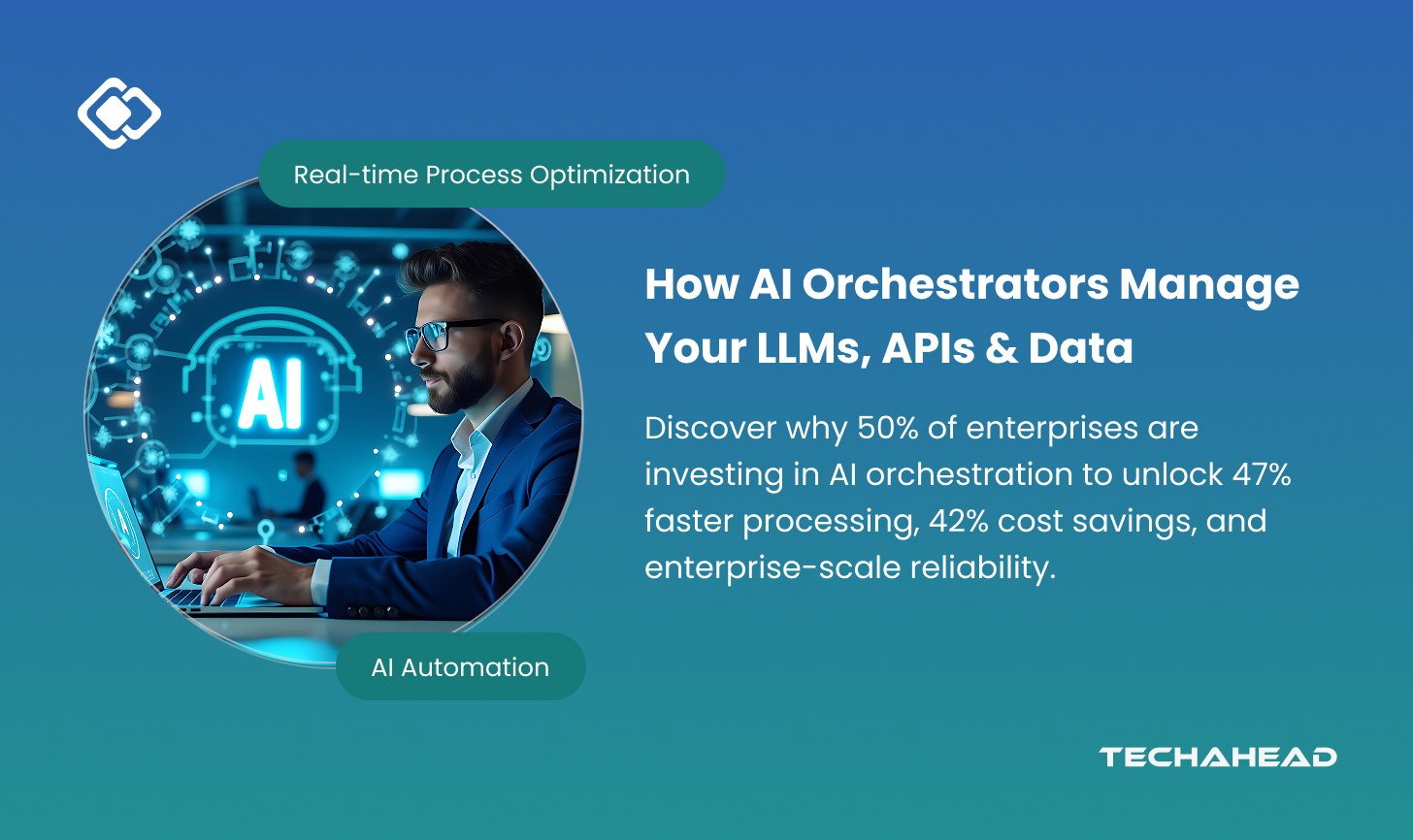The most important question which comes up during AI discussion is that, why AI orchestrator? Why should a company invest in creating an AI orchestrator, and what’s the role. of AI orchestrator in creating and managing LLMs, APIs, data flows and other structures?
The answer lies in the level of complexity an organization is aiming for.
When the first wave of AI innovation ushered in, mostly, they were standalone, isolated model deployments, which were created for specific tasks and activities.
But then, the AI ecosystem evolved into complex, intelligent, inter-connected systems, with numerous LLMs, APIs and data pipelines embedded, working together.
And thus, there was a need for a middleware, a platform which can sync and communicate with different AI components, and ensure seamless integration, governance, and scalability.
This is the AI orchestrator, which solved the problem of managing different AI components, creating a platform, a backbone of reliable, enterprise-grade implementations.
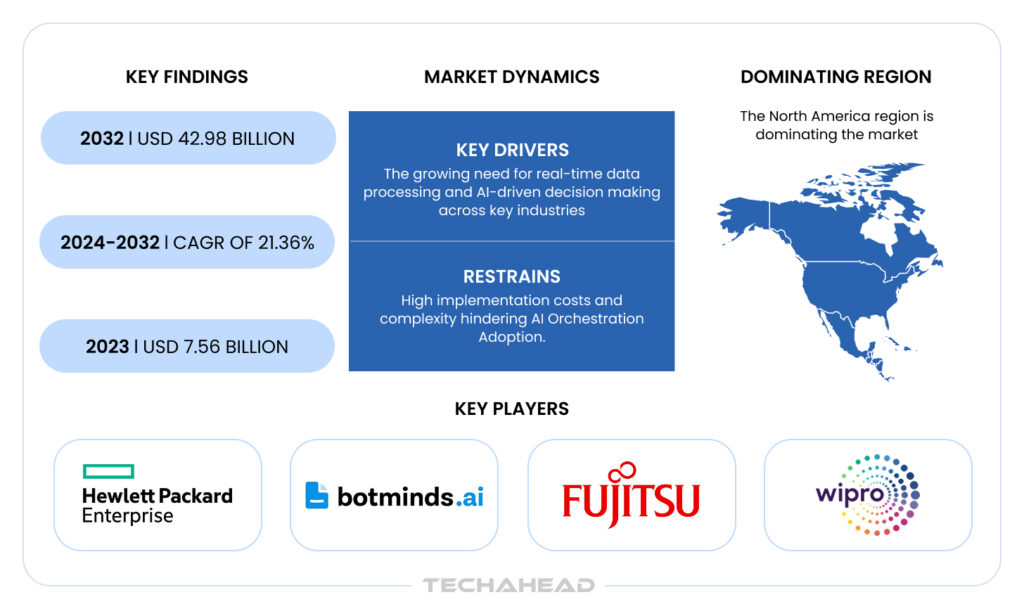
Here’s an interesting observation: By the time 2025 ends, 50% of organizations have announced their decision to prioritize their investments in AI orchestration platforms.
This has been done to operationalize and optimize numerous LLM strategies, and optimally manage complex data workflows.
Key Takeaways
- AI orchestration coordinates LLMs, APIs, and data for seamless operations
- Enterprises achieve 47% faster processing with 42% cost reduction consistently
- Governance and security features ensure compliance in regulated industries effectively
- Multi-agent collaboration defines the future of advanced AI orchestration systems
- Pilot programs minimize risks before committing to full-scale enterprise deployment
- $11B market by 2025 signals critical infrastructure for competitive advantage
Since it directly impacts the decision making capabilities of the large AI platforms, no organization can afford to ignore the importance and relevance of AI orchestration.
Globally, the market size of AI orchestration is expected to surpass $12 billion by 2025, and swell to more than $40 billion by 2032, almost complimenting the surge and expanse of AI market as a whole. No wonder, the market of AI orchestration is expanding at an impressive 20% CAGR, and it’s unstoppable as of now.
Now, this incredible growth and expansion of AI orchestration reflects one important insight: The enterprise AI landscape is no longer just about single, standalone model, but it’s about orcetrating an entire AI supply chain.

What is an AI Orchestrator?
Now, let’s start with the basics: What is an AI orchestrator?
An AI orchestrator functions as intelligent middleware that manages and coordinates multiple AI models, APIs, databases, and data sources, ensuring they operate cohesively within enterprise workflows. Think of it as the conductor of a symphony orchestra: each instrument (LLM, API, data source) plays its part, but the conductor ensures perfect timing, harmony, and seamless transitions between movements.
However, AI orchestration isn’t monolithic.
The ecosystem encompasses several distinct approaches:
Workflow Engines focus on predefined, rule-based task sequencing, routing data through specific nodes in a predetermined pattern.
Tools like Apache Airflow or Prefect excel at scheduling and dependency management for data pipelines.
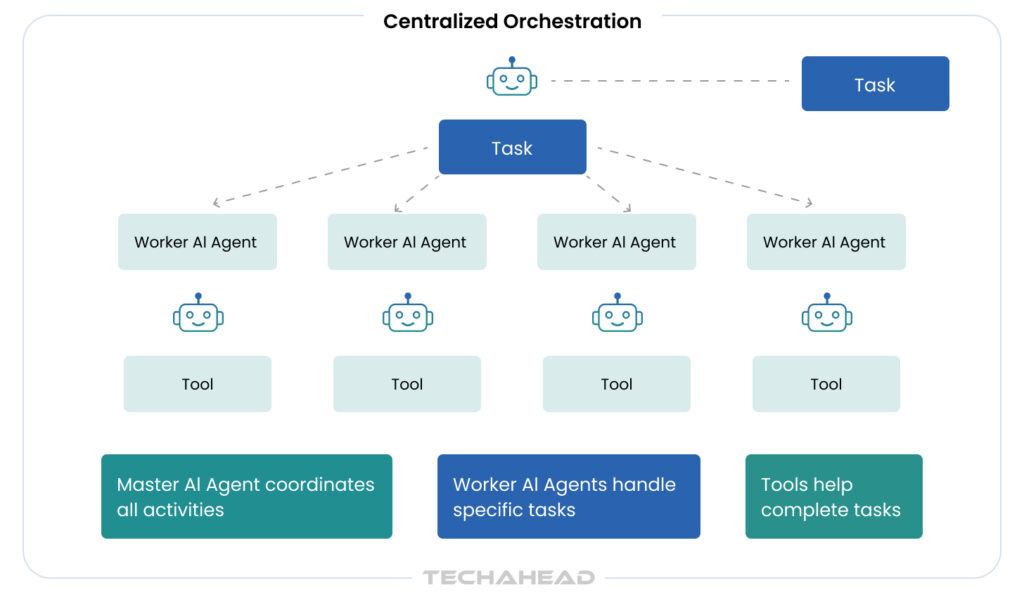
LLM Orchestrators specifically manage the lifecycle of language models, handling prompt engineering, context management, response validation, and model routing. Platforms like LangChain and LlamaIndex fall into this category, providing frameworks for building LLM-powered applications.
Agentic Orchestration represents the cutting edge, coordinating autonomous AI agents that can make decisions, invoke tools, and adapt their behavior based on real-time feedback. Solutions like AutoGPT and Microsoft’s Semantic Kernel enable multi-agent collaboration where specialized agents handle distinct tasks.
Modern enterprise implementations often blend these approaches, creating hybrid orchestration layers that manage both deterministic workflows and adaptive, agent-based processes within the same infrastructure.
Why AI Orchestration is Essential in the LLM Era
The rise of LLMs has fundamentally transformed application architecture. Modern AI applications rarely rely on a single model or API: They chain together multiple LLMs, vector databases, retrieval systems, traditional APIs, and real-time data sources.
According to Gartner’s 2024 analysis, enterprises now average 4.2 different LLM providers within their AI stack, with some organizations utilizing upwards of seven distinct models for specialized tasks.
This complexity introduces profound operational challenges:
Latency Bottlenecks: Without intelligent routing and load balancing, sequential API calls can cascade into unacceptable response times. A typical RAG (Retrieval-Augmented Generation) application might involve document retrieval, embedding generation, context filtering, LLM inference, and response validation, each step adding latency.

Inconsistent Outputs: Different models produce varying response formats, quality levels, and accuracy profiles. Orchestration ensures consistent output structure and quality through validation layers and fallback mechanisms.
Cost Inefficiency: Running every query through expensive, high-capability models wastes resources. Intelligent orchestration routes simple queries to faster, cheaper models while reserving premium models for complex tasks.
Governance Gaps: Manual integration creates compliance blind spots. Without centralized orchestration, tracking data lineage, enforcing access controls, and maintaining audit trails becomes nearly impossible.
A 2024 report from IBM found that organizations without formal orchestration experienced 3.2x higher failure rates in production AI systems and spent 47% more time on incident resolution compared to those with robust orchestration frameworks.
Core Functions of an AI Orchestrator
Integration Layer
Modern orchestrators provide pre-built connectors for diverse systems: OpenAI, Anthropic, Google Vertex AI, Azure OpenAI, AWS Bedrock, Pinecone, Weaviate, traditional RESTful APIs, GraphQL endpoints, and legacy enterprise systems. This abstraction layer shields applications from vendor-specific implementation details, enabling seamless provider switching.
Data Flow Management
Orchestrators automate the entire data lifecycle—ingestion, preprocessing, validation, transformation, routing, and post-processing. This includes:
- Automatic schema validation ensuring data integrity
- Smart routing based on content type, urgency, or business rules
- Error handling with configurable retry logic and fallback pathways
- Data enrichment through parallel API calls and context injection
Model Lifecycle Management
Production LLM deployments require sophisticated lifecycle orchestration:
- Version control for prompts, models, and configurations
- A/B testing frameworks for comparing model performance
- Canary deployments to minimize risk during updates
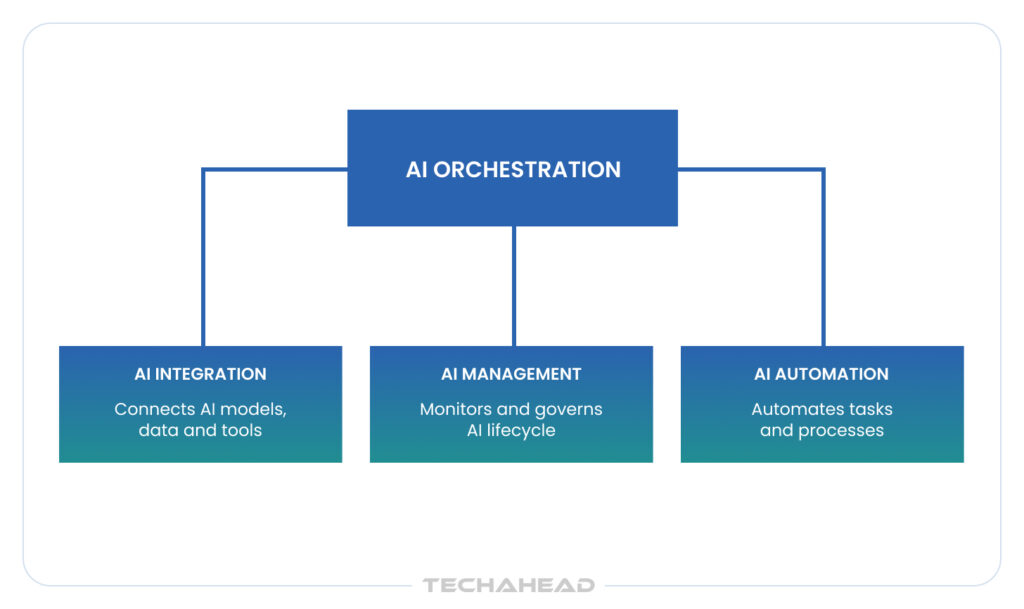
- Automatic scaling based on demand patterns
- Load balancing across multiple model instances or providers
- Rollback capabilities when new versions underperform
Real-Time Performance Analytics
Enterprise orchestrators provide comprehensive observability:
- Latency tracking at each orchestration step
- Cost monitoring across all API providers
- Quality metrics including accuracy, relevance, and hallucination detection
- SLA enforcement with automated alerting
- Anomaly detection for unusual patterns or degraded performance
Security & Governance
Critical for regulated industries, orchestration platforms enforce:
- Role-based access control (RBAC) for model and data access
- Data masking and encryption for sensitive information
- Compliance frameworks for GDPR, HIPAA, SOC 2
- Human-in-the-loop workflows for high-stakes decisions
- Comprehensive audit logs for regulatory reporting
Enterprise-Scale AI Orchestrator Architectures
Organizations deploy orchestration in various architectural patterns, each suited to different operational requirements:
Centralized Orchestration implements a control-tower approach where a single orchestration platform manages all AI workflows. This model excels in governance, providing unified visibility and control. IBM’s watsonx Orchestrate exemplifies this pattern, offering enterprise-wide coordination with centralized policy enforcement.

Decentralized Orchestration distributes orchestration logic across multiple domains or business units, with each maintaining its own orchestration layer. This peer-to-peer model offers greater autonomy and resilience but requires careful coordination to maintain consistency.
Hybrid Models combine centralized governance with distributed execution—policy and monitoring remain centralized while actual workflow execution happens closer to data sources and applications.
Deployment options similarly vary:
SaaS Platforms (Orq.ai, Domo) offer rapid deployment and automatic updates but with less infrastructure control
On-Premises Solutions provide maximum security and customization for regulated industries
Hybrid Cloud architectures balance flexibility with control, often using private clouds for sensitive workloads
Sovereign Cloud options address data residency requirements in highly regulated jurisdictions
Practical Examples & Success Stories
Financial Services: JPMorgan Chase’s KYC Transformation
JPMorgan Chase implemented an AI orchestration platform to streamline Know Your Customer (KYC) and customer onboarding processes. The orchestrator coordinates multiple LLMs for document analysis, connects to credit bureaus via APIs, validates data against regulatory databases, and routes exceptions to human reviewers.
Results:
- 40% reduction in KYC processing time
- 62% improvement in first-pass accuracy
- Enhanced compliance tracking with complete audit trails
- $120 million annual cost savings
Source: JPMorgan Chase AI Implementation Case Study
E-Commerce: Shopify’s Personalization Engine
Shopify deployed orchestration infrastructure to power real-time personalization across millions of merchants. The system orchestrates product recommendation LLMs, inventory APIs, customer behavior analytics, and pricing engines to deliver hyper-personalized shopping experiences.
Results:
- 28% increase in conversion rates
- 35% improvement in average order value
- 50% faster page load times through intelligent caching
- Real-time inventory synchronization across 2+ million merchants
Source: Shopify Engineering Blog – AI Orchestration
Healthcare: UnitedHealth Group’s Claims Processing
UnitedHealth Group implemented an orchestration platform connecting LLMs for medical coding, claims validation APIs, provider databases, and fraud detection systems. The orchestrator automatically routes complex cases to specialists while handling straightforward claims end-to-end.
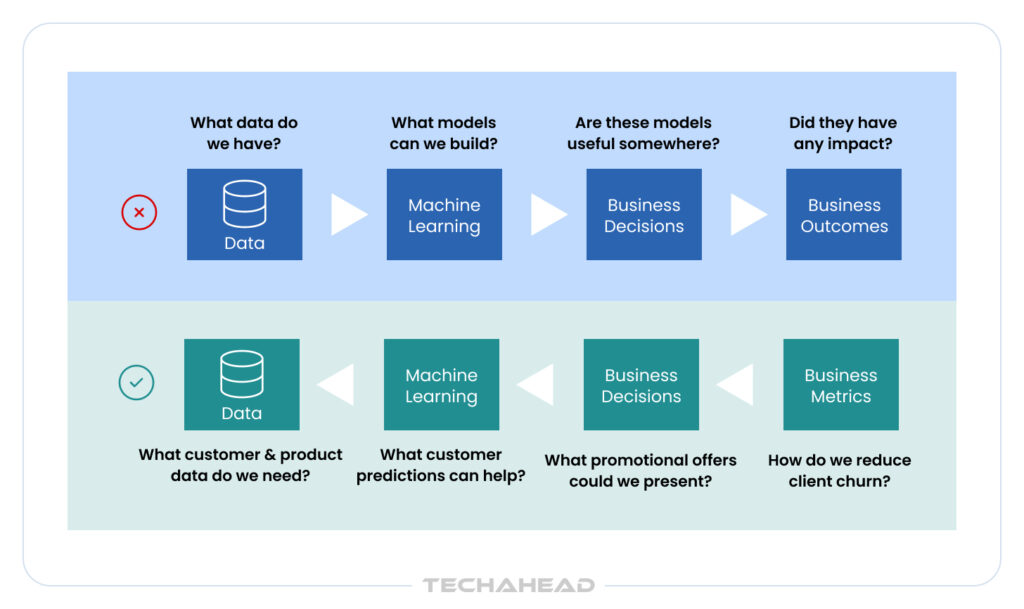
Results:
- 45% reduction in claims processing time
- 89% straight-through processing rate for routine claims
- $200 million annual operational savings
- 99.7% accuracy in automated medical coding
Source: UnitedHealth Group Innovation Report 2024
Manufacturing: Siemens Predictive Maintenance
Siemens deployed orchestration for industrial IoT monitoring, connecting real-time sensor data, predictive maintenance LLMs, spare parts inventory APIs, and technician scheduling systems. The orchestrator analyzes equipment telemetry, predicts failures, automatically orders parts, and schedules maintenance.
Results:
52% reduction in unplanned downtime
38% decrease in maintenance costs
67% improvement in parts inventory efficiency
$180 million saved across global operations
Source: Siemens Digital Industries White Paper
Enterprise Results Summary:
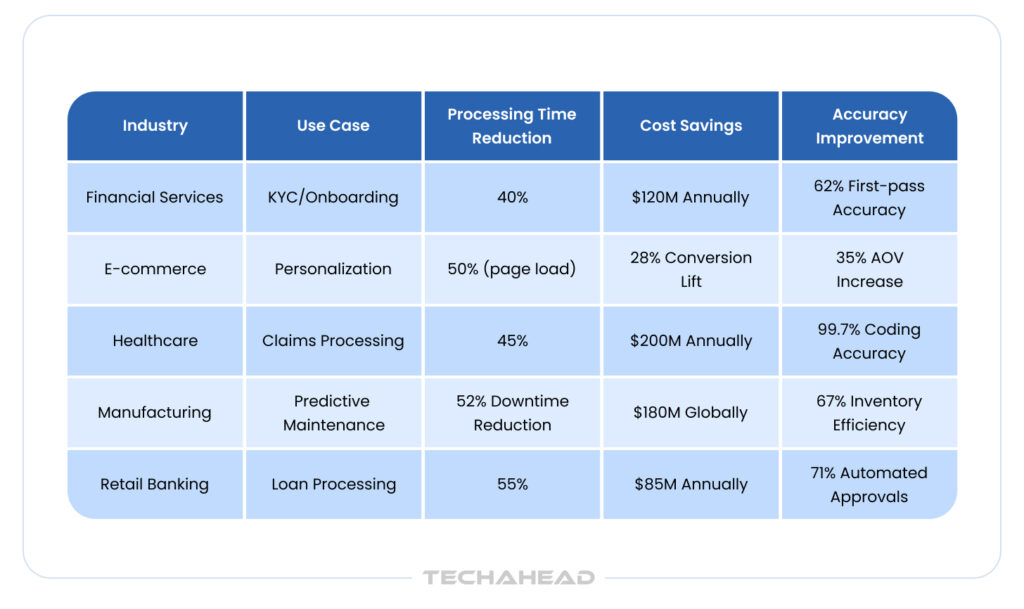
Key Features and Capabilities: Product Deep-Dive
Low-Code/No-Code Interfaces
Modern orchestration platforms democratize AI implementation through visual workflow builders. Orq.ai’s canvas-based interface allows business analysts to design complex LLM chains without writing code, while platforms like Microsoft Power Automate integrate orchestration into familiar enterprise tools.
Multi-LLM Support and Intelligent Routing
Enterprise orchestrators support dozens of models simultaneously:
- OpenAI: GPT-4, GPT-4 Turbo, GPT-3.5
- Anthropic: Claude 3 Opus, Sonnet, Haiku
- Google: Gemini Pro, PaLM 2
- Open Source: Llama 2, Mistral, Falcon
- Specialized Models: Code generation (Codex), embeddings (text-embedding-3), vision (GPT-4V)
Intelligent routing algorithms select optimal models based on query complexity, cost constraints, latency requirements, and quality thresholds. Simple queries route to fast, inexpensive models while complex reasoning tasks leverage premium capabilities.

Pre-Built API Connectors
Leading platforms provide extensive integration libraries:
- Enterprise Systems: Salesforce, SAP, Oracle, Microsoft Dynamics
- Databases: PostgreSQL, MongoDB, Snowflake, BigQuery
- Communication: Slack, Teams, Email, SMS gateways
- Cloud Services: AWS services, Azure cognitive services, Google Cloud APIs
- Specialized Tools: CRM systems, ERP platforms, BI tools
Observability and Monitoring
Comprehensive observability distinguishes enterprise-grade orchestration:
Real-Time Dashboards provide live visibility into workflow execution, model performance, cost accumulation, and error rates.
Distributed Tracing tracks requests across multiple systems, identifying bottlenecks and failures with microsecond precision.
Audit Logs capture every decision, data access, and model invocation for compliance and debugging.
Trace Replay enables reproducing failed workflows with identical inputs for root cause analysis.
Self-Healing Automation
Advanced orchestrators implement automatic remediation:
- Circuit breakers preventing cascading failures
- Automatic retry with exponential backoff
- Fallback models when primary providers fail
- Dynamic routing away from degraded services
- Auto-scaling based on load patterns
LangSmith, for example, automatically switches to alternative LLM providers when detecting elevated error rates, ensuring uninterrupted service.
Designing Reliable Data Flows with Orchestration
Data Quality and Validation
Orchestration platforms implement multi-layered validation:
Schema Validation ensures incoming data matches expected formats, rejecting malformed requests before expensive processing.
Business Rule Validation applies domain-specific logic: Verifying customer IDs exist, checking credit limits, validating geographic restrictions.
Output Validation confirms LLM responses meet quality standards, proper JSON structure, required fields present, values within acceptable ranges.
Real-Time Data Integration
Modern orchestrators handle streaming data from diverse sources:
Change Data Capture (CDC) monitors database changes, triggering workflows when critical data updates occur.
Event-Driven Architecture processes messages from Kafka, RabbitMQ, or cloud-native event buses, enabling reactive workflows.
Webhook Management handles incoming webhooks from external systems, validating signatures and routing to appropriate handlers.
Error Handling and Data Lineage
Production systems require robust error management:
Configurable Retry Policies define attempt counts, backoff strategies, and timeout thresholds per integration point.
Dead Letter Queues capture permanently failed messages for manual review and reprocessing.
Data Lineage Tracking maintains complete provenance, recording data sources, transformations, model versions, and outputs for regulatory compliance and debugging.
AI Orchestrator Selection: Criteria & Benchmarks
Leading Platform Comparison

Selection Criteria
Scalability: Can the platform handle anticipated workload growth? Look for horizontal scaling, multi-region deployment, and performance benchmarks at scale.
Integration Breadth: Does it support your existing tech stack? Evaluate pre-built connectors, API flexibility, and custom integration capabilities.
Governance Capabilities: For regulated industries, prioritize platforms with robust RBAC, comprehensive audit trails, data residency controls, and compliance certifications (SOC 2, ISO 27001, HIPAA).
Vendor Support: Consider community size for open-source options, vendor SLA commitments, documentation quality, and availability of professional services.
Total Cost of Ownership: Beyond licensing, factor in implementation costs, infrastructure requirements, maintenance burden, and vendor lock-in risks.
Extensibility: Can you add custom components, integrate proprietary models, or extend functionality as requirements evolve?

AI Orchestration Impact on Key Performance Indicators
Source: Forrester Total Economic Impact Study 2024, IDC AI Operations Survey 2024
Challenges & Best Practices
Common Pitfalls
Vendor Lock-In: Over-reliance on proprietary orchestration features creates migration barriers.
Mitigate this by favoring open standards, maintaining abstraction layers, and documenting integration points.
Underestimating Integration Complexity: Legacy system integration often consumes 60-70% of implementation effort. Budget accordingly and consider phased rollouts starting with modern APIs.
Data Security Gaps: Orchestration centralizes data flow, creating attractive attack targets. Implement defense-in-depth: encryption at rest and in transit, secrets management, network segmentation, and regular security audits.
Performance Degradation: Adding orchestration layers introduces latency. Optimize through strategic caching, asynchronous processing where appropriate, and minimizing unnecessary serialization.
Best Practices
Start with Pilot Programs: Begin with non-critical workflows, learn operational nuances, and build internal expertise before tackling mission-critical processes.
Incremental Rollout: Phase implementation across business units or use cases, incorporating feedback and refining approaches before full-scale deployment.
Cross-Functional Collaboration: Successful orchestration requires alignment between data engineers, ML engineers, application developers, security teams, and business stakeholders. Establish clear ownership and communication channels.
Comprehensive Monitoring: Implement observability from day one. You can’t optimize what you can’t measure, track latency, costs, quality metrics, and business outcomes continuously.
Governance as Foundation: For regulated industries, embed compliance requirements into orchestration design from the start. Retrofitting governance is exponentially more difficult and risky.
Documentation and Knowledge Transfer: Document architectural decisions, integration patterns, and operational procedures. Orchestration platforms represent critical infrastructure, knowledge concentration creates organizational risk.
Future Trends in AI Orchestration
Autonomous, Self-Optimizing Systems
Next-generation orchestrators will automatically tune performance, adjusting routing rules, caching strategies, and model selection based on observed patterns. Reinforcement learning techniques will enable orchestration systems to continuously improve without human intervention.
Advanced Multi-Agent Collaboration
The frontier of orchestration lies in coordinating multiple autonomous agents, each with specialized capabilities, working together on complex tasks. Microsoft’s research on multi-agent systems and frameworks like AutoGen demonstrate early examples, imagine orchestrating teams of AI agents handling customer service, with specialist agents for billing, technical support, and account management, collaborating seamlessly under orchestration oversight.
Digital Twin-Based Orchestration
Industries are exploring digital twin integration, where orchestration platforms coordinate between physical systems and their virtual counterparts. Manufacturing facilities will use orchestrators to synchronize real-world production with simulated optimization, continuously refining operations.
Interoperability Standards
The industry is moving toward standardized orchestration protocols. Organizations like the Open Application Model (OAM) and initiatives from the Cloud Native Computing Foundation (CNCF) are developing common standards for workflow definition, monitoring, and portability, reducing vendor lock-in and improving ecosystem interoperability.
Continuous Compliance and Auditing
Future orchestrators will provide real-time compliance validation, automatically checking workflows against regulatory requirements, identifying potential violations before they occur, and maintaining continuously audit-ready documentation.
Industry analysts increasingly describe AI orchestration as “the next CRM for AI operations”, a fundamental operational platform that every enterprise running production AI will require. Gartner predicts that by 2027, over 75% of enterprises will have implemented formal AI orchestration platforms, making it as ubiquitous as current API management or CI/CD infrastructure.
Conclusion
AI orchestrators have evolved from technical curiosities to business-critical infrastructure. As enterprises deploy increasingly sophisticated AI systems—chaining multiple LLMs, integrating diverse APIs, managing complex data flows—orchestration provides the essential coordination layer ensuring these components work reliably, securely, and efficiently.
The evidence is compelling: organizations implementing robust orchestration see dramatic improvements across every dimension—47% faster processing, 42% cost reduction, 56% quality improvement, and 63% faster feature deployment. These aren’t marginal gains; they represent transformational operational improvements that directly impact competitive positioning.
Readiness Assessment Checklist
Evaluate Current State
- How many different LLMs, APIs, and data sources power your AI applications?
- Are integration patterns documented, standardized, and maintainable?
- Can you track data lineage, model versions, and decision provenance for compliance?
- What percentage of AI incidents stem from integration issues versus model performance?
Pilot Selection
- Identify a high-value but non-critical workflow as your orchestration pilot
- Ensure executive sponsorship and cross-functional team representation
- Define clear success metrics before implementation
- Budget 3-6 months for pilot deployment and optimization
Scaling Roadmap
- Establish governance frameworks before expanding orchestration
- Create centers of excellence for knowledge sharing and best practices
- Invest in training for developers, operations teams, and business users
- Plan infrastructure scaling to support additional workloads
Security and Compliance
- Conduct security reviews of orchestration architecture
- Implement comprehensive logging and audit trails from day one
- Validate compliance with relevant regulations (GDPR, HIPAA, SOC 2)
- Establish incident response procedures for orchestration failures
Is Your AI Stack Ready for True Orchestration?
The question facing enterprises isn’t whether to implement AI orchestration, but when and how. As AI systems grow more complex and business-critical, manual integration and ad-hoc coordination become untenable. Orchestration isn’t a luxury for cutting-edge adopters, it’s rapidly becoming table stakes for reliable, scalable, governable enterprise AI.
Organizations that invest in orchestration now position themselves to capitalize on AI’s full potential: faster innovation cycles, lower operational costs, stronger governance, and ultimately, better business outcomes. Those that delay risk accumulating technical debt, operational fragility, and competitive disadvantage.

It coordinates multiple LLMs, APIs, and data sources, ensuring seamless integration, governance, and reliable enterprise-grade performance.
Manual integration creates latency bottlenecks, inconsistent outputs, governance gaps, scaling issues, and significantly higher operational failure rates.
Financial services, healthcare, e-commerce, manufacturing, and retail banking see transformational improvements through orchestrated AI workflows.
Through intelligent routing, automatic fallbacks, load balancing, version control, real-time monitoring, and comprehensive error handling mechanisms.
Most enterprises see measurable returns within 6-9 months through reduced costs, faster processing, and improved operational efficiency.
Yes, modern orchestrators provide pre-built connectors and custom integration capabilities for legacy APIs, databases, and enterprise systems.
Role-based access controls, encryption, audit logs, compliance frameworks, data masking, human-in-the-loop workflows, and secrets management.

